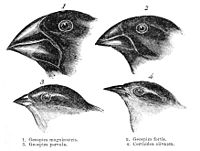
Photo from wikipedia
ABSTRACT Molecular clock calculations suggest a late Cambrian (~ 500 Ma) divergence of myriapod classes. Yet, the earliest myriapods only appear in the latest Silurian (~425 Ma). 75 million years… Click to show full abstract
ABSTRACT Molecular clock calculations suggest a late Cambrian (~ 500 Ma) divergence of myriapod classes. Yet, the earliest myriapods only appear in the latest Silurian (~425 Ma). 75 million years later; though correlation with the standard marine-based geological time scale is difficult. We radiometrically dated (U/Pb method) zircons in sediments at 3 sites in the UK associated with the supposed earliest millipedes. Kerrera, with only extinct kampecarid myriapods from temporary playa lake deposits in a semi-arid intermontane basin is 425 Ma old. Ludlow, with kampecarid myriapods and the first trigonotarbid arachnids (with book lungs), from transported material in ripple troughs at the base of a semi-arid delta complex, is 420 Ma. Cowie, with the supposed earliest air-breathing millipede (with spiracles), from a temporary playa lake in an intermontane basin complex, is 414 Ma old. The more diverse land arthropod fauna of the Rhynie Chert hot spring deposit, also in an intermontane basin, is 407 Ma old. A rapid radiative evolution from simple intermontane lake margin communities through more evolved lowland communities took only about 40 Ma to reach complex forest grade communities by the Middle Devonian Givetian (about 385 million years).
Journal Title: Historical Biology
Year Published: 2020
Link to full text (if available)
Share on Social Media: Sign Up to like & get
recommendations!